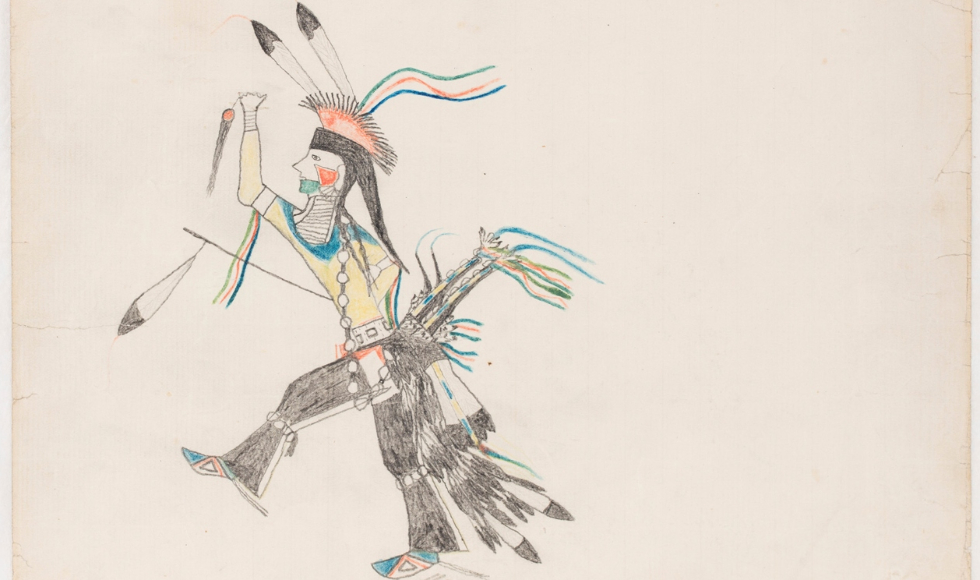New exhibition confronts ‘Indian’ image and stereotypes

Iron Cloud / Mahpiyamaza: Iron Cloud performing Counting Coup or Scalp Dance, c. 1876 pencil and crayon on paper, Simcoe County Museum
A new exhibition at the McMaster Museum of Art refutes the well-known adage “history is written by the victors,” encouraging visitors to activate their peripheral vision to see beyond their direct line of sight, exploring histories not at the centre of the dominant worldview.
Peripheral Vision(s), which is supported by the Terra Foundation for American Art, sparks a visual dialogue between 19th-century ledger drawings by Northern Plains warrior-artists and the lithographic prints of 20th-century U.S. artists Leonard Baskin and Fritz Scholder.
“Essentially, Peripheral Vision(s) is a critical rethinking of the origins of the ‘Indian’ image, endeavouring to understand how artists have shaped – and been shaped by – this image,” says Rhéanne Chartrand, curator of Indigenous art at the museum, and co-curator, along with Gerald McMaster, of Peripheral Vision(s).
“It invites visitors to consider how the lens of the present shapes our understanding of the past.”
The exhibition draws together nearly 50 works of art from institutions across North America.
Twenty-one ledger drawings record, in meticulously truthful detail, the first-hand experiences of four 19th-century warriors turned artists. These include Short Bull / Tȟatȟáŋka Ptéčela (Sičháŋǧu Lakota, c. 1845–1923), Pretty Eagle / Déaxitchish (Apsáalooke, 1846–1903), White Swan / Mee-nah-tsee-us (Apsáalooke, 1851–1904), and Iron Cloud / Mahpiyamaza (Lakota, 1851–?).
Within the exhibition space, these ledger drawings are placed into conversation with 12 of the 27 “Indian portraits,” in McMaster’s collection by Jewish-American artist, Leonard Baskin (1922-2000) and fourteen lithographs by Luiseño/American artist, Fritz Scholder (1937-2005), borrowed from five prominent U.S. institutions.
The artists in this exhibition occupied the periphery of mainstream Euro-American society, history, art and culture during their lifetimes. Though almost a century separates them, they are bound together by their common creative pursuit of reflecting on vision(s) of self, of Other, of place and on particular moments and events in ways that do not conform to, or uphold, the accepted “truths” of history.
“Together these artworks generate a new critical analysis of history, the politics of representation, image-making, and the overall intent of portraiture,” says Chartrand.
The Museum is organizing several free public events — including a concert — to complement Peripheral Vision(s):
- Curator’s tour by Rhéanne Chartrand: Wednesday, Sept. 25, 12:30 p.m. – 1:20 p.m.
- A Night of Indigenous Music: Award-winning Indigenous cellist Cris Derksen and
contemporary trio nêhiyawak: Thursday, Sept. 26, 7 p.m. – 9 p.m. - Panel Discussion: Wednesday, Nov. 20, 6 p.m. – 9 p.m.
- Janet Berlo, professor of art/art history and visual culture, University of Rochester
- Gerald McMaster, curator, artist, author, and Tier 1 Canada Research Chair of Indigenous visual culture and curatorial practice, OCADU
- Jeffrey Thomas, artist and recipient of the 2019 Governor General Award for the Visual & Media Arts
- Rhéanne Chartrand, curator of Indigenous art, McMaster Museum of Art
The exhibition will also be accompanied by a significant publication exploring the “Indian” image, with scholarly essays by some of the most prominent Indigenous and non-Indigenous voices within the fields of Indigenous art history and art criticism today.
For more information about the exhibition, please contact:
Rhéanne Chartrand, Curator of Indigenous Art, McMaster Museum of Art, at chartrr@mcmaster.ca

